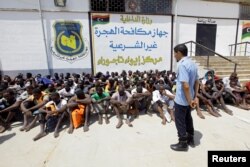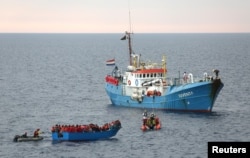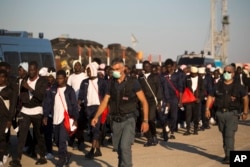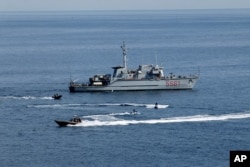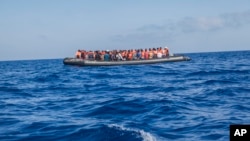Italian government ministers are becoming increasingly divided over risky naval efforts to curb the numbers of migrants who have landed at the country’s ports.
At issue — what the mission should be for two Italian naval ships set to be deployed in Libyan waters. Several ministers object to the idea of Italian sailors turning back mainly sub-Saharan asylum-seekers — either directly or indirectly in coordination with Libyan Coast Guard ships, some of whom are suspected of being in league with people smugglers.
The emerging cracks in the Italian government policy come as a ship leased to a far right anti-migrant group started to shadow refugee-rescue vessels operated by humanitarian organizations, raising fears of a possible dangerous confrontation at sea with the far-right activists from Defend Europe.
The number of migrants who have arrived in Italy this year totals more than 95,000, although in the past two weeks the rate of arrivals has eased slightly. About 2,000 migrants attempting the sea crossing this year have drowned. In the past four years, about 600,000 migrants have arrived on Italian shores — the majority of whom departed from Libya and made the hazardous journey across the Mediterranean Sea.
The mass influx has strained Italy’s emergency and humanitarian system almost to the breaking point and is a source of increasing political tension among Italy’s political parties. It is likely to dominate next year’s national elections and is worsening the electoral prospects of the center-left coalition government of Prime Minister Paolo Gentiloni.
Last week, parliament approved the limited Italian naval mission to help Libya’s coast guard regulate the flow of migrants and prevent human trafficking. On Sunday, a leading opponent of the mission, Deputy Foreign Minister Mario Giro, said, “Turning migrants back to Libya at this moment means returning them to hell.”
His remarks were prompted by reports that on Saturday, Libya's Coast Guard announced it had “recovered and saved” more than 800 migrants near its coast. Giro says that returned “migrants end up in detention centers in the hands of militias, who take advantage of them to do their business.” He says just returning migrants to Libya won’t alleviate a huge humanitarian crisis."
Giro, a member of the Sant'Egidio Community, an influential Catholic volunteer association, also defended NGOs, which are being blamed by populist parties and some in the government for acting as a collective “pull factor” for migrants by mounting rescue missions.
The NGOs have been accused of coordinating pick-ups with people smugglers — something the humanitarian organizations vehemently deny. NGO heads say they are merely doing what European governments should be doing more of — rescuing migrants at risk of drowning. NGOs are now responsible for picking up more than 40 percent of those rescued at sea.
The head of Medecins Sans Frontieres (Doctors Without Borders), Tommaso Fabbri, says, “The responsibility to organize and conduct search and rescue operations at sea lies — as it always has — with states. As such, our current rescue activities are simply filling the void left by Europe.”
Last month, the government of Italy introduced a code of conduct restricting what refugee-rescue charities are allowed to do, if they want to land migrants at Italian ports. Among other requirements, they are to refrain from patrolling within Libya’s territorial waters.
Only three out of eight NGOs operating in the southern Mediterranean have agreed to the Italian terms. A vessel operated by the German NGO Jugend Rettet was seized last week off the coast of the island of Lampedusa by Italian coast guard vessels for breaching the code and the ship has now been impounded while investigations continue.
Giro is seen by the Italian media as the spokesman for an influential group of parliamentarians featuring left-wingers and Catholics. He acknowledges some NGOs subscribe to “a no border ideology, a kind of humanitarian extremism,” but he argues, “In the face of the tragedy that’s happening, I prefer humanitarian extremism to other types of extremism.”
His views are in direct confrontation with former Communist and Interior Minister Marco Minniti, the exponent of a tough, security-focused line on migration.
The 61-year-old Minniti wants to close Italian ports to any NGOs failing to sign the code of conduct, a proposal frowned on by transport minister Graziano Delrio. And he was the main exponent for the Italian naval mission after persuading Prime Minister Fayez Serraj, the head of an internationally recognized government in Libya, to welcome the mission.
The Italian naval mission to Libya is not only under threat from opposition within the Italian government. Now a Libyan warlord has threatened to bomb the Italian ships.
Minniti has warned that the Democratic Party and its coalition partners face electoral disaster next year, if they fail to take mounting public anger seriously and come up with ways to curb the flow of asylum-seekers, most of whom are economic migrants fleeing poverty, rather than refugees fleeing war.
Anti-migrant rage is obvious in slogans daubed in cities and even in towns that have been allotted only a few thousand migrants. In San Benedetto del Tronto, a seaside resort on Italy’s Adriatic coast, high-school students shocked their teachers in July by daubing across a large mural the slogan “Stop The Immigration Business!” The mural adapted an Edward Hopper painting, replacing a yellow hay field with a dark and stormy sea and a boat loaded with migrants.





